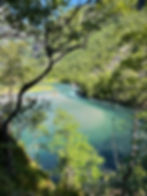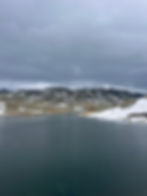Five days in Norway
- theworldthroughbooks
- May 8, 2024
- 6 min read
I’ll start by saying that five days is nowhere near enough to see Norway. Norway is huge. But you have to start somewhere. This itinerary covers two of Norway’s major cities as well as some of its stunning countryside, both from a train window and on a scenic hike. This is a summer itinerary (we visited in June) but the cities are year-round destinations.
I’ve included an interactive map at the end of this article which shows our route in red and the attractions mentioned in this article in blue.
Day 1 – Bergen to Myrdal

Bergen is a coastal city, known (among other things) as the “heart of the fjords” in Norway. Its harbour is lined with timber buildings in bright shades of yellow, orange and red. Bryggen Hanseatic Wharf is a UNESCO World Heritage Site – previously a trading hub, the structures on the seafront, and further inland, are now shops and cafés. Sit and have a coffee out at a table on the cobbled pavement, and watch the boats as they come and go from the harbour.
Walk round the harbour and through the fish market. The catch is fresh and could not be more local, caught earlier that day in the sea around the city. You can find various fish and seafood restaurants here and it’s a good spot for lunch.
If you have time, you could get your culture fix by visiting a museum. You’re spoilt for choice here – you could try:
Edvard Grieg Museum at Troldhaugen – home, and now museum, of Norwegian composer Edvard Grieg
KODE – an art museum spread over four locations, with paintings by Norwegians including Edvard Munch
Bergen Maritime Museum – museum showcasing Bergen’s maritime history
Old Bergen Museum – museum showing what Bergen was like in the 1880s (closed during the winter)
If you can get to Bergen the evening before day 1, you’ll get to experience it for a little longer as you’ll need to catch an afternoon train towards Oslo. The whole of that train route is about seven hours and, having travelled the whole route (see further below), I can confirm the truth of its reputation as one of the most beautiful train journeys in the world. The train takes you past fjords, mountains, forests… all the typical scenery you would expect to see in Norway!

Disembark at Myrdal. There are limited options for places to stay in Myrdal but Vatnahalsen Høyfjellshotell AS was an excellent find. It’s a large, reddish, wooden chalet, laid out beautifully with a library/pool room, a cosy lookout room with windows all around and views over the mountains, comfortable rooms and a large dining room. For an extra cost, you can have a substantial homemade dinner. The salmon provided here was genuinely a highlight of our trip – it was so much fresher and meatier than the salmon I was used to in England!
Day 2 – Myrdal to Flåm
The path from Myrdal to Flåm is about 12 miles and is mostly on a gentle downhill slope. We hiked it but other options are also available – you can:
catch the famous Myrdal to Flåm train (more on this below);
zipline down the steepest part of the descent, right out of Myrdal. This is the longest zipline in Scandinavia at 1300m (you would still have to get the rest of the way to Flåm by another method); or
hire bikes, including electric bikes.

The route is easy to follow, easy to walk and overall a beautiful active day. It takes you along a river of meltwater from the glaciers above, passing waterfalls of all sizes, and crisscrossing the railway. The whole hike took us about six hours, including a stop for a picnic lunch, and you’ll know you’re nearly there when you reach Flåm kyrkje (church). It’s then just under an hour into the centre of Flåm. Read more about the Myrdal to Flåm hike (link coming soon).
Flåm sits on the edge of a fjord. Although it has only about 400 permanent inhabitants, it is a popular destination for cruise ships so its main business is tourism. When we arrived, the town was fairly quiet but a cruise ship arrived the next morning and the town became much more crowded.

A word about tourism in Flåm: in general, I avoid places which are widely written about and described as “authentic” or “hidden gems” as this signals to me that they are small and/or pretty places that have become tourist hotspots. To me, this makes the experience inauthentic because it is impossible to get a sense of what life is like for the people who live there. I liked Flåm but I would suggest taking it with a pinch of salt – it’s in a beautiful location but it is basically a tourist town.
Day 3 – Flåm to Myrdal
We woke up early with the sun streaming into our room, the fjord outside still and glassy. In the distance, a cruise ship was approaching silently.

After breakfast at Flåm Bakery, we hiked up to a viewpoint beside Brekkefossen, a waterfall with a view over Flåm and the fjord. The trail is popular and clearly marked. It involves a fairly steep climb up some stone steps but it is wholly worth the effort when you emerge beside the waterfall. Misty water cascades down from a great height, its spray catching the light and reflecting a rainbow arching across the falls. The view is spectacular and Flåm looks like a toy town – little red houses with pointed roofs sit amongst green fields; the Myrdal-Flåm railway snakes around the edge and the flat fjord between the hills flanking it expands towards a snow-capped mountain.
Back in Flåm, we visited a small beach on the edge of the fjord. I stuck to paddling as the fjord is glacially cold but it was a welcome coolness from the hot sun. The air feels very clean and clear in Norway so perhaps that makes the sun feel hotter.
We needed to get back to Myrdal that day but found ourselves stuck. We did not want to hike back as it was all uphill, and we could not hire bikes because we needed to carry our bags with us. The road at Myrdal is inaccessible by car so there are no taxis there. Our only option was the Myrdal to Flåm train.
Although the train is a bit of a tourist trap, and although we had walked the same route in the other direction the previous day, I have to say it is actually a lovely journey. It passes the various waterfalls, the river, through tunnels carved through mountains… and it slopes upwards more steeply than any other train in the world which, with my limited knowledge of engineering, I understand is an impressive feat. You can disembark briefly at Kjosfossen, a thundering waterfall cascading down the side of hill in a cloud of white foam. The train then continues for another few minutes to Myrdal station.
Day 4 – Myrdal to Oslo
After breakfast we went for a walk around the Reinungavatnet, a fjord near our hotel. Reinungavatnet is surrounded by trees and at times you have to jump over little streams through which the fjord is replenished by waterfalls on the other side of the path.

In the early afternoon, we caught the train from Myrdal to Oslo, picking up from where we had started the journey at Bergen. This section of the journey started rather more bleakly – it had begun to rain and the temperature outside had dropped. The landscape was much more sparse than before and, instead of the forests we had seen between Bergen and Myrdal, we now passed grey rocks, leading up to snowy mountains, and several fjords which still had ice floating on their surfaces.
Further through the journey, the scenery brightened up and we began to pass through some tiny towns with the ubiquitous red panelled walls and pointed roofs. Once again we saw pine forests, sweeping fjords, and glacial rivers fed by towering waterfalls. After five hours, we arrived in Oslo.
Day 5 – Oslo
Norway’s capital is quiet as capital cities go but that should not deceive you into thinking there is nothing to do.
Oslo is a modern city with lots of new developments and lots of history. You can visit the ruins of St Clement’s Church, thought to date from the twelfth century. There is also the Akershus Fortress, a medieval castle still functioning as a centre of bureaucracy. Oslo is also a very green city, and Slottsparken in particular, surrounding the Royal Palace, is a hub for picnics or walks when the weather is warm.
Oslo’s seafront is lined with restaurants and bars, with the Opera House standing out as an architectural feat due to its flat roof which doubles as a viewing platform across the bay.
So there you have it
Although five days isn’t anywhere near enough time for such a huge and beautiful country, use this suggested itinerary for five wholesome days in Norway, packing in a mix of culture, city living and fresh countryside.